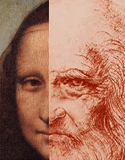
|

|
Science and Art is a seminar course with a preview on the diverse intersections of science, and technology in creating, viewing, understanding, authenticating, conserving and restoring works of art. This course involves a consideration of the physics and biology of color vision, luminance, perspective, shading and chiaroscuro, stereoptics, illusions of motion, and the science of pigmentation, color mixing and resolution, as well as aspects of the mathematics and physics implicit or explicit in the composition of drawings and paintings. Chemical properties of different media will be studied to better understand the technical difficulties an artist must overcome when working in a particular medium such as paint on canvas. Scientific methods used widely in the study of existing paintings such as infrared reflectography, ultraviolet light, x-radiography, optical microscopy, and scanning electron microscopy will be described at an introductory level and used to examine the "history" of a painting over time. Recent conservation efforts and scientific investigations of specific paintings from various epochs of time will be considered. Once sufficient background has been introduced, the provocative hypothesis of the contemporary artist David Hockney that many historical masterworks of art were created with the aid of optical devices and projection of images will be critically considered and serve as an exercise in scientific method. There will be extensive use of web-based learning modules and a variety of in-class experiments and demonstrations.
COURSE FORMAT: Lecture
Level: UGRD Credit: 1 Gen Ed Area Dept: NSM CHEM Grading Mode: Graded
Prerequisites: NONE
Last Updated on MAR-21-2005
Copyright Wesleyan University, Middletown, Connecticut, 06459